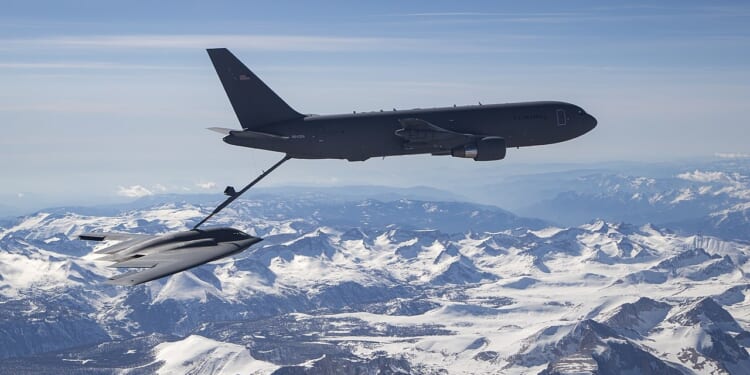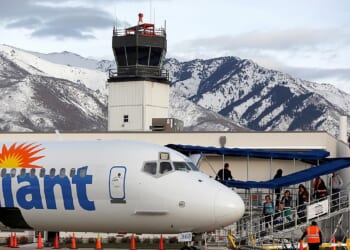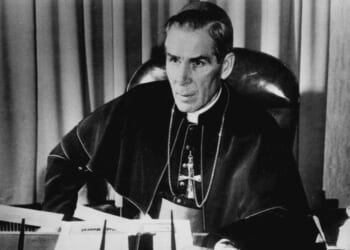No other nation on earth can launch a global strike, with a stealth platform, from its own soil—a capability that the B-2 Spirit gives the US Air Force.
The Northrop Grumman B-2 Spirit made headlines in June for “Operation Midnight Hammer,” its bombing mission against fortified nuclear facilities in Iran. The strike, authorized by President Donald Trump, was notable not just for the fact that the B-2s violated Iran’s airspace and dropped America’s largest non-nuclear bombs, but also because the aircraft’s missions both started and ended in Missouri—making for a 37-hour non-stop flight.
The B-2 Spirit’s Specifications
- Year Introduced: 1997
- Number Built: 21
- Length: 69 ft 0 in (21.0 m)
- Height: 17 ft 0 in (5.18 m)
- Wingspan: 172 ft
- Weight:
- Empty weight: 158,000 lb (71,700 kg)
- Gross weight: 336,500 lb (152,200 kg)
- Max takeoff weight: 376,000 lb (170,600 kg)
- Top Speed: High subsonic
- Service Ceiling: 50,000 feet
- Loadout: 40,000 lb
- Aircrew: 2
The B-2 Spirit Is Built for Endurance
How does the B-2 complete such marathon missions?
The first enabler is fuel. The B-2 can carry more than 160,000 pounds of fuel internally. Should it consume all 160,000 pounds, it is also equipped to refuel in air. So between the cavernous internal capacity and the aerial refueling ability, the B-2’s range is practically limitless. The only real constraint, therefore, is not the machine, but the two pilots within.
Unlike a cramped, nearly anatomical fighter cockpit, the B-2 cockpit was designed with human endurance in mind. While the cockpit holds just two crew members, behind the seats is a surprisingly roomy compartment that allows the two pilots to rotate duties across missions that can stretch beyond 40 hours.
The compartment includes a small bunk, so one pilot can sleep while the other flies. Space is relatively generous, allowing the pilots to stand, stretch, and even exercise lightly to keep blood flowing. Storage areas allow the crew to pack personal gear, including pillows, comfort food, and books—which can help blunt the monotony of multi-day sorties.
The B-2 also features modest amenities for meals and hygiene. Crews can heat up pre-packaged food in a small oven, or use a hot-water dispenser to make coffee. Unlike fighter pilots, the B-2’s pilots also have access to a makeshift lavatory, allowing bodily functions to be completed comfortably. And while hot water and a private toilet may all sound ordinary or trivial, they are not, as they functionally transform the B-2 cockpit into a livable environment. Without them, missions like June’s Iran excursion would not be possible.
Long-Range Bomber Missions Are Physically—and Mentally—Taxing
Despite the accommodations, the B-2 crew is strained heavily. Pilots must endure strange rhythms for multi-day missions: short bursts of sleep in a bunk, sudden jolting awake to take the controls of a $2 billion aircraft, many hours of silence and relative inactivity, heated rations consumed at odd intervals, and the anxiety of operating behind enemy lines—not to mention the responsibility of dropping earth-shattering ordnance on a distant foe. Physical discomfort naturally accumulates—stiff muscles, dry eyes, and the compounding fatigue of managing complex systems under pressure. Psychologically, the crew faces very real challenges, too. Twenty, thirty, forty hours—with no visual cues beyond clouds and darkness. Pilots must push through fatigue, making perfect decisions while deploying precision-guided ordnance, even nuclear ordnance.
When all is said and done, the physical and psychological hardships are worth the strategic benefits. No other nation on earth can launch a global strike, with a stealth platform, from its own soil. The B-2 and its crew’s endurance allows for that unique capability, which fundamentally alters the geopolitical calculus of all US adversaries.
About the Author: Harrison Kass
Harrison Kass is a senior defense and national security writer at The National Interest. Kass is an attorney and former political candidate who joined the US Air Force as a pilot trainee before being medically discharged. He focuses on military strategy, aerospace, and global security affairs. He holds a JD from the University of Oregon and a master’s in Global Journalism and International Relations from NYU.
Image: Wikimedia Commons.

















